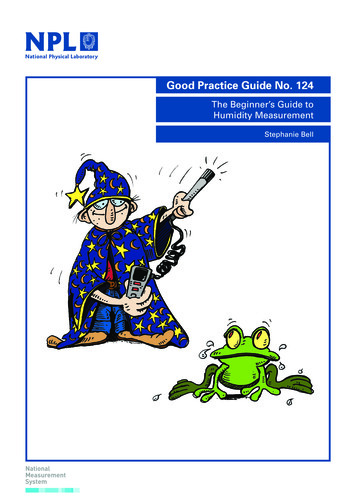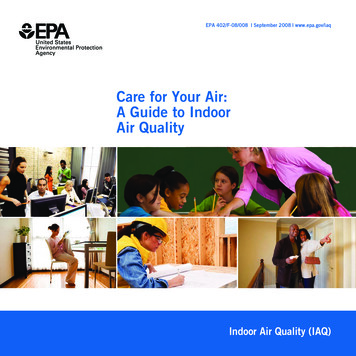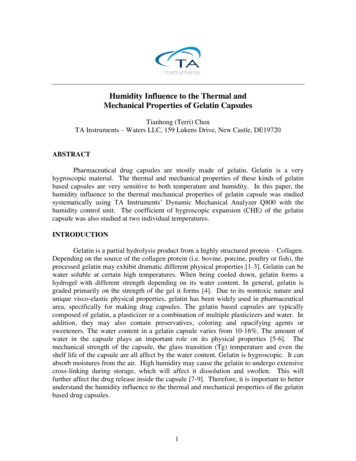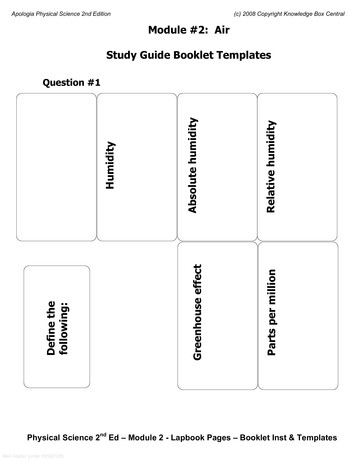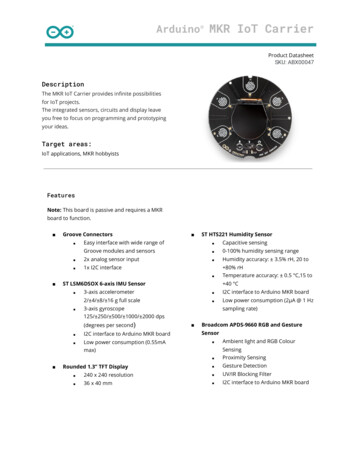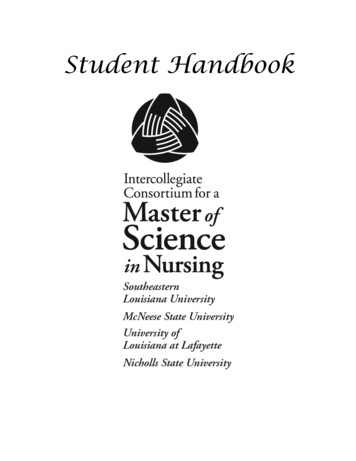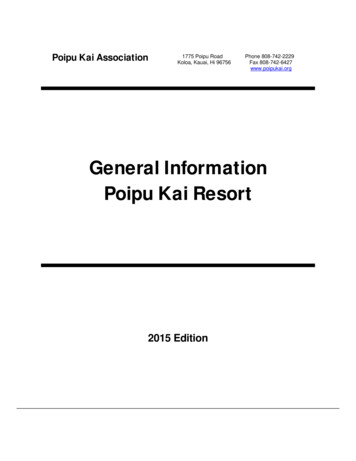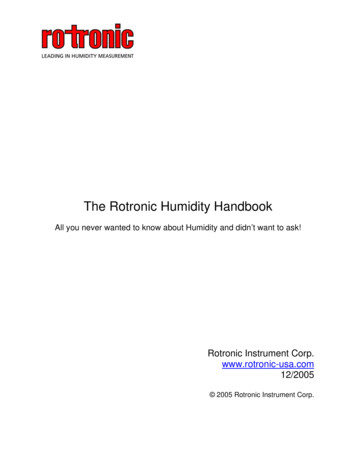
Transcription
The Rotronic Humidity HandbookAll you never wanted to know about Humidity and didn’t want to ask!Rotronic Instrument Corp.www.rotronic-usa.com12/2005 2005 Rotronic Instrument Corp.
Humidity Fundamentals . 8Relative Humidity, Pressure and Temperature . 8Foreword8Ideal Gas Laws8Mole Fractions and Partial Pressure10Effect of a Change In Pressure10Real Gases10Vapor Pressure Above a Liquid11Vapor Pressure of Water12Vapor Pressure of Water Mixed with Another Substance12Vapor Pressure Above Ice13Definitions of Humidity13Vapor Concentration (Absolute Humidity)13Specific Humidity14Mixing Ratio14Volume Mixing Ratio15Relative Humidity15Dew Point and Frost Point Temperature16Wet Bulb Temperature16Effect of Temperature and Total Pressure on Vapor Pressure16Effect of Temperature and Pressure on %RH17Examples17Relative Humidity Calibration19Method of Calibration19Temperature Stability19Temperature of Calibration19Altitude20Influence of Temperature Variations on Solutions20Are they all the same? Choosing the Right Humidity Instrument. 21Principle of Operation21Classification of Errors22Linearity Errors22Temperature Errors22Hysteresis23Calibration Errors23Long Term Stability24Choosing a Humidity Instrument24Rotronic Instrument Corp.Page 2
Wet Bulb / Dry Bulb - Description and Limitations. 25Summary25Problem Areas in the Wet- and Dry-Bulb Technique25Non-Observance of Basic Requirements25Interferences During Measurements26Poor Handling and Maintenance26Typical Accuracy of the Wet- and Dry-Bulb Technique27Operational Limitations of the Wet- and Dry-Bulb Technique27Technical Information for Rotronic Products. 30Water Activity Instruments: A Comparison of Two Measuring Techniques . 30Water Activity Measuring Techniques30Speed of Measurement30Temperature Stability30Accuracy31Range of Measurement32Maintenance33Summary33Chemical Resistance of Rotronic Hygromer Humidity Sensors . 34General34Uncritical chemicals34Critical Chemicals35Application Examples35Humidity Measurement in Sterilization Chamber (Ethylene oxide)35Humidity Measurement in An Ozone Chamber36Special Application – Humidity Measurement in Oil36Competitor Comparison 2004 . 37HVAC Transmitters - Wall Mount37Humidity Deviation at 1 C41Humidity Deviation at 40 C42Temperature Deviation at 50 %rh43Industrial Transmitters with Cable Probes44Humidity Deviation at -10 C47Humidity Deviation at 23 C48Humidity Deviation at 70 C49Temperature Deviation at 50 %rh49Page 3The Rotronic Humidity Handbook
Humidity Deviation From Set Point at 23 C After Different Humidity and TemperatureConditions50HygroClip Performance Over A Range of %RH & Temperature Conditions . 53Evaluation of Competitive Humidity Sensors . 55Temperature Limits56Response Time57Reset Rate58Long Term Accuracy59Dew Point Stability60Rotronic C-94 Response Time . 61Long Term Performance of the HygroClip S and C-94 Sensor. 62Application Stories and Tales. 70Last Long and Prosper (A water activity tale) . 70Ingredients and Interactions71Factors Affecting Stability72Stimulating Storage Conditions73Speed it Up74Precautions and Possibilities75Paper & Climate. 77Introduction77Influence of Moisture Content on Paper77Influence of Equilibrium Relative Humidity on Paper77Static Electricity78Dust Problems in Presses78Dimensional Changes of Paper during Printing78Deformations of Paper Due to Humidity79Deformation of Paper Due to Temperature79Curling of Paper Sheets80Drying Time of Printing Inks80Recommended Values of % ERH81Recommended Tolerance of % ERH81Summary81Automotive Test Chamber Features Rotronic-Transmitters . 82Performance Surpasses Expectation!82Oresund Bridge Maintenance Cost Slashed . 83The Rotronic Humidity HandbookPage 4
Jens Olsens’ Worldwatch in Copenhagen . 84Renovation Necessary84Munters Dehumidifier Ensures Conditions84Munters Leading Dry Air Supplier85Cool Application for Rotronic Humidity Technology . 86Abbey Library St. Gall. 87Rotronic Conquers the Jungfrauhoch. 88The Holy Shroud - The Wounds of the Passion. 89Measuring Water Activity at the “Millennium Seed Bank” . 90The New Treasure Chamber in Cologne’s Cathedral . 92Rotronic HygroLog-D: Data Loggers in Church Organs. 93Now, what happens to an organ when the climate is wrong?93Application: Pyramid of Saqquara Egypt . 95A New Discovery95Need for Preservation95Technology Assists96Rotronic Sensors on Kilimanjaro. 97Rotronic Measuring Equipment in Nuclear Research. 98Analysis of Drilling Mud in Canada . 100HygoClip S – When Maximum Precision is Required . 102What Does Humidity Have to Do with Deep Space Missions? . 103The European Deep Space Antenna Project in New Norcia (Western Australia)103Rotronic Sensors in the Brick Industry. 105Humidity Absorption from Munters with Rotronic Humidity Instruments . 106Climate Surveillance in Vienna Palace Liechtenstein . 108Use of the Palace over the course of centuries108Climate Control108Humidity Measurement on the Moving Paper Web . 110Web Probe BFC-DIO111Testing Water Activity in Seeds Helps the Brazilian Rainforest . 112Engine Testing at SAAB . 114New Ventilated Radiation Shields Co-Developed with MeteoSwiss . 115How Rotronic Helps in the Production of Fine Cheese . 117Page 5The Rotronic Humidity Handbook
Protecting Rodin from Japan’s Climate and Earthquakes . 118How Humidity is used in Fuel Cell Research. 119Why the Dew Point is Measured?119The Challenge of Measurement in Fuel Cell Testing119Who are the Customers?120HygroClip Probes and the Quality of Plastic Molding. 121Advantages from the Customer’s Point of View121Further Applications for DAS-Systems:122Humidity Generators - Examining Uncertainty . 123Other Helpful Information. 128Temperature Conversion Table. 128Glossary. 129The Rotronic Humidity HandbookPage 6
HumidityFundamentalsRotronic Instrument Corp.Page 7
Relative Humidity, Pressure and TemperatureHumidity FundamentalsRelative Humidity, Pressure and TemperatureForewordThis technical note reviews the basic laws of physics that govern relative humidity.Within a temperature range of -50 to 150 C and at pressures not in excess of 1000 kPa,water vapor practically behaves like an ideal gas. Examples are provided to illustrate theinfluence of temperature and pressure on relative humidity and to show how to convertrelative humidity into dew point and absolute humidity.This note is largely inspired from the textbook Chemistry by Theodore L. Brown and H.Eugene LeMay, JR. (Prentice-Hall, 1977).Ideal Gas LawsBy definition, an ideal gas follows the following laws:Boyle's Law: this law states that at constant temperature, the product of the volume andpressure of a given amount of gas is a constant.P x V constantThe value of the constant depends on how much gas is in the volume.Charles's Law: this law states that at constant pressure, the volume of a given quantityof gas is proportional to absolute temperature ( K).V qxTwhere q is a proportionality constant that depends on the quantity of gas.Charles's law can be stated in another form: at constant volume, the pressure of a givenquantity of gas is proportional to absolute temperature.P jxTwhere j is a proportionality constant that depends on the particular sample of gas and itsvolume.The Rotronic Humidity HandbookPage 8
Humidity FundamentalsNote: to convert temperature in C into absolute temperature in K, add the constant273.15.Dalton's Law of Partial Pressures: this law states that that the total pressure of a mixtureof gases is equal to the sum of the pressures that each gas would exert if it werepresent alone.Pt P1 P2 P3 .where P1, P2, etc., are the partial pressures of gases 1, 2, etc.Avogadro's Hypothesis: this hypothesis states that equal volumes of gases at the sametemperature and pressure contain equal numbers of molecules. For instance, one literof any ideal gas at a temperature of 0 C and a pressure of 101.3 kPa, contains 2.688 x1022 molecules.Note: the temperature of 0 C and pressure of 101.3 kPa is the standard temperatureand pressure condition or STP.Volume of a Mole of Gas at STP:A mole of any element is defined as the amount of that element that contains the samenumber of molecules (or atoms in the case of a mono atomic element) as exactly 12 gof 12C (Carbon 12).It has been experimentally determined that the number of atoms in this quantity of 12Cis 6.022 x 1023. This number is called Avogadro's number.As one liter of gas, at STP, contains 2.688 x 1022 molecules (or atoms in the case of amono atomic gas), it follows that a mole of gas (6.022 x 1023 molecules) occupies avolume of 22.4 l, at STP.Ideal Gas Law: this law states that the product of volume and pressure of a givenamount of gas is proportional to absolute temperature.PxV nxRxTwhere n is the number of moles of gas and R the molar gas constant.The constant R is equal to:0.08206 atm x liter/ K x mole.Page 9The Rotronic Humidity Handbook
Relative Humidity, Pressure and Temperature8.30928 Pa x m3/ K x moleMole Fractions and Partial PressureThe composition of one mole of a gas mixture can be expressed in terms of the molefractions of its components. The mole fraction of a particular component is defined asthe total number of moles of the component divided by the total number of moles of allthe components. From this definition, it follows that the sum of all mole fractions is equalto one. Taking dry air near sea level as an example, the mole fractions of the three maincomponents are as follows:NitrogenOxygenCarbon Dioxide: 0.78084: 0.20948: 0.00954If Pt is the total pressure of a gas mixture and n1, n2, etc. the mole fractions of itscomponents, it follows that:Pt Pt x (n1 n2 .) andPt Pt x n1 Pt x n2 .where Pt x n1, Pt x n2, etc. are the partial pressures of components 1, 2, etc.The above equation is another form of Dalton's law.Effect of a Change In PressureDalton's law states that the total pressure of a gas mixture is equal to the sum of thepartial pressures of its components. From this, it was derived that the partial pressure ofa component is equal to the product of the total pressure times the mole fraction of thecomponent.Therefore, a change in the total pressure of a gas mixture, at constant composition,results in the same change in the partial pressure of each component. For instance,doubling the total pressure of a gas mixture results in doubling the partial pressure ofeach component.Real GasesReal gases fail to obey the laws of ideal gases to greater or lesser degree. The van derWaals equation corrects the equation established for ideal gases:The Rotronic Humidity HandbookPage 10
Humidity Fundamentals(P an2/V2)(V - nb) nRTwhere a and b are constants that depend on the nature of the gas.From the van der Waals equation, it is apparent that a real gas tends to behave like anideal gas when the volume of gas is large.The constant b of most common gases is less than. At STP, the number of moles n isequal to one when the volume V equals 22.4 l. Therefore, most real gases behavealmost like ideal gases when placed in a large volume at moderate pressure(1000 kPa or less).Vapor Pressure Above a LiquidMolecules in a liquid are closer one to another than they are in a gas. Therefore,intermolecular forces are stronger than in a gas. For a liquid to vaporize, theintermolecular forces have to be overcome by the kinetic energy of the molecules.If a liquid is placed in a closed container, the particles entering the vapor phase cannotescape. In their random motion, many particles strike the liquid and are recaptured byintermolecular forces. Thus two processes occur simultaneously: evaporation andcondensation.The rate of evaporation increases as temperature increases. This is so because anincrease in temperature corresponds to an increase in the kinetic energy of molecules.At the same time, the rate of condensation increases as the number of particles in thevapor phase increases: more molecules strike the surface of the liquid. When these twoprocesses become equal, the number of particles and, therefore, the pressure in thevapor phase, becomes stabilized.The value of the equilibrium vapor pressure depends on the attractive forces betweenparticles of the liquid and on the temperature of the liquid. Vapor pressure above aliquid increases with increasing temperature.The presence of gases other than vapor above a liquid does not affect the kineticenergy of molecules inside or outside the liquid and does not affect the magnitude of theintermolecular forces in the liquid. Therefore, vapor pressure above a liquid does notdepend on the total pressure above the liquid.Page 11The Rotronic Humidity Handbook
Relative Humidity, Pressure and TemperatureVapor Pressure of WaterThe vapor pressure of water, or saturation vapor pressure, increases strongly withincreasing temperature:Temperature( C)0102030405060708090100Water .1847.3470.11101.33 1 atmVapor Pressure of Water Mixed with Another SubstanceIf water is mixed with a non volatile substance to form a non electrolyte solution, thevapor pressure is proportional to the mole fraction of water in the solution (Raoult's law).Because of the electrostatic attraction between ions, electrolyte solutions do not exactlyfollow Raoult's law.This can be explained as follows:At a given temperature, the kinetic energy of all particles (molecules, ions) in thesolution is the same. Essentially the same number of particles are at the surface in boththe solution and pure water. However, in the case of the solution, only the watermolecules can escape from the solution. As these represent only a fraction of the totalnumber of particles present at the surface, vapor pressure is lowered.The Rotronic Humidity HandbookPage 12
Humidity FundamentalsThe following table provides a few examples of saturated salt solutions (electrolytesolutions) at a temperature of 25 C:SoluteLiCLMgClNaClKClVapor pressure(kPa)0.3581.0392.3872.673Pressure RatioSolution/Pure Water11.3 %32.8 %75.3 %84.3 %Vapor Pressure Above IceWhen water freezes, the molecules assume a structure which permits the maximumnumber of hydrogen-bonding interactions between molecules. Because this structurehas large hexagonal holes, ice is more open and less dense than liquid water. Ashydrogen-bonding is stronger in ice than in liquid water, it follows that the intermolecular attraction forces are the strongest in ice. For that reason, vapor pressureabove ice is less than the vapor pressure above liquid water.Temp( C)0-5-10-15-20-25-30Vapor PressureLiquid (kPa)0.6110.4220.2870.1910.1260.0810.049Vapor PressureIce iq.1.000.950.910.860.820.780.75Definitions of HumidityVapor Concentration (Absolute Humidity)The vapor concentration or absolute humidity of a mixture of water vapor and dry air isdefined as the ratio of the mass of water vapor Mw to the volume V occupied by themixture.Dv Mw / V , expressed in grams/m3 or in grains/cu ftThe value of Dv can be derived as follows from the equation PV nRTPage 13The Rotronic Humidity Handbook
Relative Humidity, Pressure and TemperatureMw nw x mw, where :nw number of moles of water vapor present in the volume Vmw molecular mass of waterDv Mw / V nw x mw / V mw x p / RT , where:mw 18.016 gramp partial pressure of water vapor [Pa]R 8.31436 Pa x m3 / K x moleT temperature of the gas mixture in KDv p / 0.4615 x T [g / m3]1 gr (grain) 0.0648 g (gram)1 cu ft 0.0283168 m3Dv [gr / cu ft] 0.437 x Dv [g / m3]Specific HumiditySpecific humidity is the ratio of the mass Mw of water vapor to the mass (Mw Ma) ofmoist air.Q Mw / (Mw Ma)Q p mw / (p mw (Pb – p) ma)Q 1000 p / (1.6078 Pb – 0.6078 p) [ g / kg]1 gr (grain) 0.0648 g (gram)1 lb 0.4535923 kgQ [gr / lb] 7 x Q [g / kg]Mixing RatioThe mixing ratio r of moist air is the ratio of the mass Mw of water vapor to the mass Maof dry air with which the water vapor is associated:r Mw / MaMw nw x mw mw x p V / RTMa na x ma ma x pa V / RT ma x (Pb – p) V / RT, where:nw number of moles of water vapor present in the volume VThe Rotronic Humidity HandbookPage 14
Humidity Fundamentalsna number of moles of dry air present in the volume Vmw 18.016 gramma 28.966 gramp partial pressure of water vapor [Pa]pa partial pressure of dry air [Pa]Pb total or barometric pressure [Pa]R 8.31436 Pa x m3 / K x moleT temperature of the gas mixture in KV volume occupied by the air – water vapor mixturer mw p / ma (Pb – p)r 621.97 x p / (Pb – p) [g / kg]1 gr (grain) 0.0648 g (gram)1 lb 0.4535923 kgr [gr / lb] 7 x r [g / kg]Volume Mixing RatioThe volume mixing ratio is the ratio of number of moles of water vapor nw to the numberof moles of dry air na with which the water vapor is associated. This usually expressedin terms of parts per million:PPMv 106 x nw / nanw p V / RTna pa V / RT ma x (Pb – p) V / RT, where:p partial pressure of water vapor [Pa]pa partial pressure of dry air [Pa]Pb total or barometric pressure [Pa]R 8.31436 Pa x m3 / K x moleT temperature of the gas mixture in KV volume occupied by the air – water vapor mixturePPMv 106 x p / (Pb – p)Relative HumidityRelative humidity is the ratio of two pressures: %RH 100 x p/pswhere p is the actual partial pressure of the water vapor present in the ambient and psthe saturation pressure of water at the temperature of the ambient.Page 15The Rotronic Humidity Handbook
Relative Humidity, Pressure and TemperatureRelative humidity sensors are usually calibrated at normal room temperature (wellabove freezing). Consequently, it generally accepted that this type of sensor indicatesrelative humidity with respect to water at all temperatures (including below freezing).As already noted, ice produces a lower vapor pressure than liquid water. Therefore,when ice is present, saturation occurs at a relative humidity of less than 100 %. Forinstance, a humidity reading of 75 %RH at a temperature of -30 C, corresponds tosaturation above ice.Dew Point and Frost Point TemperatureThe dew point temperature of moist air at temperature T, pressure Pb and mixing ratio ris the temperature to which the air must be cooled in order to be saturated with respectto water (liquid).The frost point temperature of moist air at temperature T, pressure Pb and mixing ratio ris the temperature to which the air must be cooled in order to be saturated with respectto ice.Wet Bulb TemperatureThe wet bulb temperature of moist air at pressure Pb, temperature T and mixing ratio r isthe temperature which the air assumes when water is introduced gradually byinfinitesimal amounts at the current temperature and evaporated into the air by anadiabatic process at constant pressure until saturation is reached.Effect of Temperature and Total Pressure on Vapor PressureWhen considering the effect of temperature and pressure on the partial pressure ofvapor, it is essential to make a difference between the following situations: saturation (liquid or ice) vs. no saturation (vapor only); closed container of fixed volume vs. open space.Saturation:The partial pressure of vapor is equal to the saturation pressure and its value dependsonly on temperature. There is no difference between the situation in an openenvironment and that in a closed container.No SaturationWater vapor behaves almost like an ideal gas and the following equation appliesregarding the partial pressure of vapor:The Rotronic Humidity HandbookPage 16
Humidity FundamentalspxV nxRxTa) In an open space: the volume V occupied by vapor is free to expand. Therefore, thepartial pressure p is not affected by temperature. The partial pressure p can vary only ifn varies (vapor is being added or removed) or if the total pressure varies (Dalton's lawof partial pressures). For instance, total pressure drops with increasing altitude and thisresults in a decrease of the partial pressure of vapor.b) In a closed container of fixed volume: vapor occupies the entire volume of thecontainer and this volume is constant. Therefore, the partial pressure p can vary only ifthere is a change in absolute temperature (degrees K) or a change in the amount ofvapor. The partial pressure p does not vary with a change in total pressure.Effect of Temperature and Pressure on %RHSaturation vapor pressure depends only on temperature. There is no effect of totalpressure and there is no difference between the situation in an open space and that in aclosed container.From the above it follows that:a) in an open space, at constant moisture level and temperature, %RH is directlyproportional to the total pressure. However, the value of %RH is limited to 100% as pcannot be greater than ps.b) in an open space, at constant moisture level and pressure, %RH decreases stronglyas temperature increases.c) in a closed container of fixed volume, %RH decreases as temperature increases,however not quite as strongly as in the situation of the open space.Examplesa) Office BuildingFor practical purposes, an office building can be considered as an open environment. Alocalized increase in temperature created by a heater or an office machine, does notmodify the value of the partial pressure of water vapor. Therefore, the local vaporpressure is the same as elsewhere in the building. However, the saturation vaporpressure is locally increased. Consequently, relative humidity in the immediate vicinity ofthe heat source is lowered.If we assume that elsewhere in the building temperature is 25 C and relative humidity50 %, a localized increase of temperature to 30 C lowers relative humidity as follows:Page 17The Rotronic Humidity Handbook
Relative Humidity, Pressure and Temperatureps at 25 C 3.17 kPaps at 30 C 4.24 kPap 0.5 x 3.17 kPa 1.585 kPa, corresponding to 50 %RHLocalized %RH 100 x 1.585/4.24 37.4%b) Dew on a Chilled MirrorIf the temperature of a mirror is lowered to precisely the value that makes dew appear atthe surface of the mirror, the value of the mirror temperature is called dew point. Usingthe previous example, the dew point corresponding to a condition of 50 %RH and 25 Ccan be found as follows:ps at 25 C 3.17 kPap 0.5 x 3.17 kPa 1.585 kPa, corresponding to 50 %RHIf there is equilibrium between the dew on the mirror and the environment, it follows thatps at the temperature of the chilled mirror must be equal to the vapor pressure p. Basedon a simple interpolation of the values of the saturation vapor tables, we find that avalue of ps of 1.585 kPa corresponds to a temperature of 13.8 C. This temperature isthe dew point.This example shows that converting relative humidity into dew point and vice versarequires the use of a thermometer and saturation vapor tables.c) Compression in a Closed ChamberIf the total pressure inside a closed chamber is increased from one to one and a halfatmospheres and temperature is maintained constant, the partial pressure of watervapor is increased 1.5 times. Because temperature is maintained constant, thesaturation pressure ps is not changed. If we assume that we had a condition of 50 %RHand 25 C before the compression, the condition after compression is 75 %RH and25 C.The Rotronic Humidity HandbookPage 18
Humidity Fundamentalsd) Injection of a Dry Gas in a Closed ChamberIf, for instance, dry nitrogen is injected in a closed chamber where there is already air ata condition of 50 %RH and temperature is maintained constant, total pressure in thechamber increases. However, the partial water vapor pressure p remains constantbecause the mole fraction of water vapor in the chamber decreases by an amount thatexactly balances the increase in total pressure (see Dalton's law). Because temperatureis maintained constant, the saturation vapor pressure ps is also unchanged. Therefore,relative humidity stays at 50 % in spite of the fact that a dry gas was injected in thechamber.Relative Humidity CalibrationMethod of CalibrationA frequent method of calibrating a relative humidity instrument is to place the humiditysensor in a closed container. By putting a known solution of water and anothersubstance inside the container, a known humidity is established at equilibrium. Thishumidity value is used to provide a reference against which the instrument can beadjusted or calibrated.Temperature StabilityObtaining equilibrium conditions is one of the most critical requirements of the method.This means that there should be no difference of temperature between the humiditysensor, the solution and the head space above the solution. Unstable temperatureduring calibration will not permit this. A temperature stability of 0.02 C/min or better isrequired during the calibration process for the method to be accurate.Temperature of CalibrationThe relative humidity values generated by the different solutions used to the purpose ofcalibration, are affected by temperature. Therefore, a correction must be made for thetemperature of calibration. However, no correction is required for the effect oftemperature on the total pressure inside the calibration container.The temperature of calibration may also be restricted by the design of the instrument.For instance, an instrument that provides a compensation for the effect of temperatureon the humidity sensor does so by assuming that the temperature of calibration isalways the same. In that case, the manufacturer provides a recommendation as to therange of calibration temperature that result in the best overall accuracy for theinstrument.Page 19The Rotronic Humidity Handbook
Relative Humidity, Pressure and TemperatureAltitudeBecause vapor pressure above a solution is not affected by total pressure, no correctionis required for altitude.Influence of Temperature Variations on SolutionsA saturated solution results of the dynamic equilibrium of two processes: formation of asolution and crystallization. If a saturated salt solution is used for calibration, attentionmust be paid to this equilibrium. Because solubility depends on temperature, a variationin the temperature of a saturated solution can disturb the dynamic equilibrium processin the solution. Time must be allowed for equilibrium when the temperature of asaturated solution is changed. This time period is usually significantly longer than thetime required by the temperature of the solution to stabilize at a new value.Non saturated solutions adapt faster to a change in temperature because they do notrequire a dynamic equilibrium between a crystal and a liquid. This is convenient for usein field calibrations where temperature is not precisely known ahead of time.Most solutions release or absorb heat during their preparation. For that reason,solutions should be prepared in advance.The Rotronic Humidity HandbookPage 20
Humidity FundamentalsAre they all the same? Choosing the Right Humidity InstrumentNovember 2004Copyrighted material, reprinted with permission from Pharmaceutical Formulation & Quality MagazineSelecting the right relative humidity instrument for a specific application can beconfusing, largely because most instruments on the market have specifications that arealmost identical. Consider, for example, the accuracy specification. Many instruments,of all cost and quality levels, specify accuracy of 2.0% RH or even better, regardlessof the conditions to be measured. Is it possible that instruments that are so widelydifferent both in design and cost are all equally good? Is an accuracy range of 1.0% to2.0% RH commonplace? What about the long term stability of the humiditymeasurement? What role should it play into the decision process when selecting a RHinstrument?This article will first look at the principle of operation of capacitive humidity sensor
The Rotronic Humidity Handbook Page 4 Humidity Deviation From Set Point at 23 C After Different Humidity and Temperature

